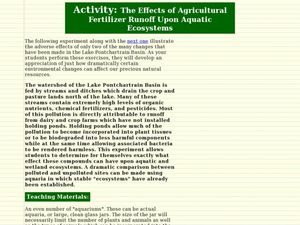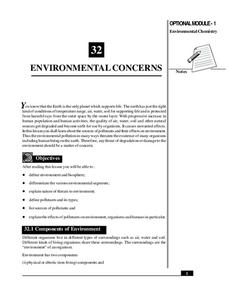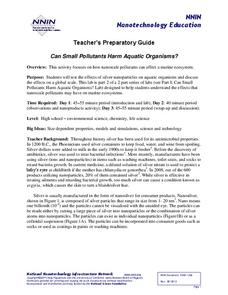Curated OER
The Effects of Agricultural Fertilizer Runoff Upon Aquatic Ecosystems
Students measure the toxic levels of runoff and discuss the effects it would have on the aquatic system. For this runoff lesson plan, students answer questions to how runoff would affect the animals in an aquatic system.
Curated OER
Lead and Children: Toxic Exposure!
Students access the Thinkport website to read, synthesize, and summarize information regarding lead poisoning. They write brief constructed responses to a research guide concerning lead poisoning.
National Library of Medicine
Your Environment, Your Health: Chemicals in Your Home
Many people know about chemical pollution, but are all chemicals bad? The third unit in a series of six addresses chemicals common in everyday life. Scholars learn about the chemicals found in their own homes, chemical safety, and...
Curated OER
Environmental Justice in Chester, PA
Over several days, learners communicate and defend an argument regarding environmental justice issues in Chester, PA. After discussing the issue and viewing a video about the location of several toxic waste facilities in Chester, they...
Mr Gym
Nuke Walk
Take a look at this cooperative learning activity. The goal of the activity is to transport nuclear waste (a cup of water) from point A to point B without spilling the toxic waste. There are several ideas given here for things to use to...
National Institute of Open Schooling
Environmental Concerns
Every year, more than 14 billion pounds of garbage is dumped into the oceans of the world, most of which is plastic and toxic to ocean life. Lesson 32 in the series of 36 focuses on environmental concerns, specifically pollution. Under...
National Institute of Open Schooling
Aldehydes, Ketones and Carboxylic Acids
Although their name makes them sound dangerous or toxic, carboxylic acids are found throughout nature in things such as citric acid, vinegar, and even in your DNA. Through detailed readings, discussions, and answering questions...
NOAA
Chemosynthesis and Hydrothermal Vent Life
What's life like in a hydrothermal vent? Find out in part five of a 13-part series. Learners journey to one of the harshest environments on the planet, the hydrothermal vent, to learn about the creatures that survive the extreme...
Beyond Benign
Shampoozled—Part 1: Formula Calculation
Time for your classes to show off what they've learned! The 11th installment in the series of 24 uses concepts learned in the previous 10 lessons to create the perfect shampoo formula. Their formulas consider both sustainability and...
Beyond Benign
The Story of Cosmetics Video Assessment
Does your shampoo contain carcinogens? Scholars learn how cosmetic companies create and market their products, many of which contain toxic chemicals. They examine the bias and consumer responsibilities in the industry.
National Nanotechnology Infrastructure Network
Can Small Pollutants Harm Aquatic Organisms?
Nanoparticles have toxic effects on plant and animal life—even though you can't see them. The second instructional activity of a two-part series has young scientists conduct an experiment that exposes plant and animals to nanoparticle...
Curated OER
Watershed Works: Unit 3
Geology whizzes observe the effects of change within a model of a watershed. They place replica waste dumps within the models and note the path that the waste takes as water passes through. This detailed lesson plan provides teacher...
Curated OER
Easily Confused Words: Lead and Led
Although not quite as confusing as their, they're, and there, many people have difficulty with lead, lead (the toxic metallic), and led. Review these basic sentences with your third and fourth graders, and have them complete the short...
Bridge
Mercury - Mercury is Rising
Hold a discussion in your class about the increase in mercury being found in fish that are caught commercially as food for humans. Given a worksheet, learners then calculate how much fish a person can safely eat each month to remain...
Curated OER
Fertilizers, Pesticides and Health
Pupils apply real data to create and calculate algebraic equations. Students create a visual to represent the concentration for one part per million and apply unit analysis to verify measurement computations. Pupils define the use of a...
Curated OER
Hazard Symbols
In this hazard symbols worksheet, students are given 6 symbols commonly used in the lab for hazardous materials, agents and situations. Students look for each symbol around the classroom, on worksheets and in textbooks.
Curated OER
Hazardous Waste Hot Potato
Students investigate hazardous substances. They work in groups to decide how to properly dispose of such materials..
Curated OER
Subsurface Contamination of Groundwater
High schoolers watch a demonstration with a balloon filled with water being buried in a milk container that has been cut length wise and filled with sand. Students are told that there is an underground storage tank filled with a...
Curated OER
Lead Usage Through History
Students read 2 assigned articles about lead usage with a partner or team. They create a concept map or timeline using Inspiration software to trace the uses of lead by people. They complete a brief constructed response and are graded...
Beyond Benign
Daphnia Bioassay LD50
De-icing materials may have a harmful effect on our environment; have your class perform an experiment to test the nature of these effects. Scholars monitor the survival rate of a sample of daphnia as the concentration of a de-icing...
Royal Society of Chemistry
Lead Compounds: Precipitation Reactions and Pigments—Microscale Chemistry
Colorful lead compounds never fail to impress! Solubility scholars examine a series of double replacement reactions involving lead nitrate and record their observations. The second part of the experiment illustrates the differences...
NOAA
Seafood and Human Health
Whether your young biologists realize it or not, humans play a significant role in marine ecosystems. To help them understand this fact children first create graphical representations that show homo sapiens' place in marine food chains,...
Polar Trec
Bioaccumulation of Toxins
In 2015, Peter Cook found that sea lions with high levels of exposure to toxins suffered permanent brain damage if they survived at all. Scholars learn about the accumulation of toxins at various levels of the food chain. Using...
Curated OER
Hazardous Household Products Quiz
In this hazardous products quiz, students give short answers to fifteen questions related to hazardous material found in or around the home. Students are questioned about what to do in given situations.
Other popular searches
- Oil Toxicity
- Household Chemicals Toxicity
- Toxicity Daphnia
- Toxicity Daphna
- Toxicity Solutions
- Toxicity Bisphenol A
- Mitochondrial Toxicity
- Toxicity of Salt
- Acute Toxicity
- Toxicity Bis Phenol A

























